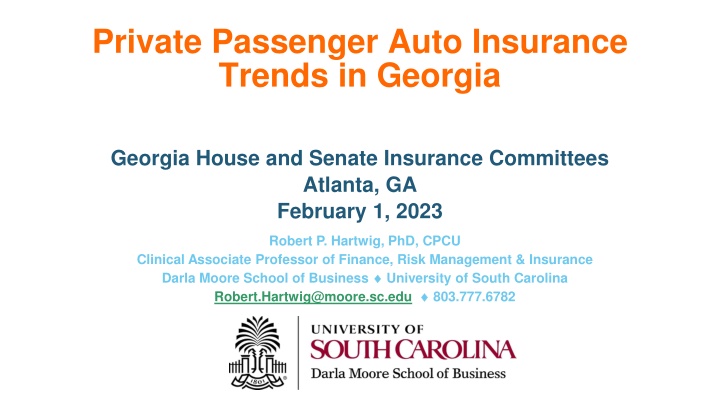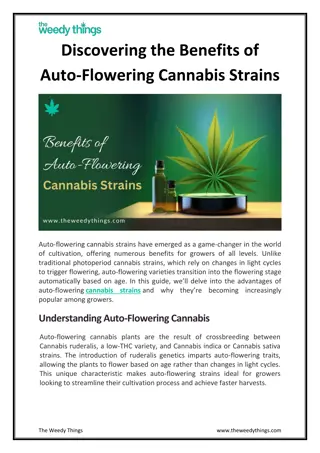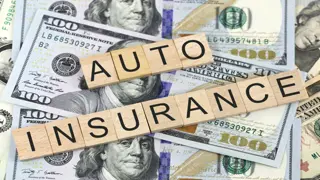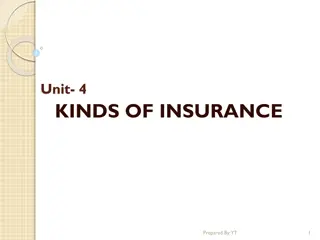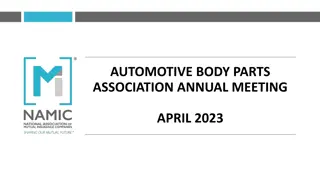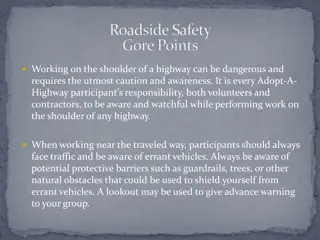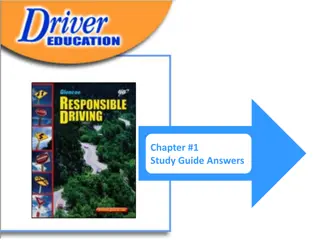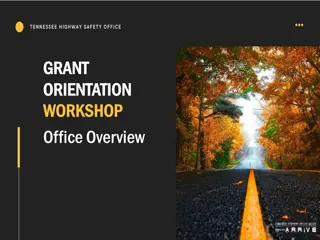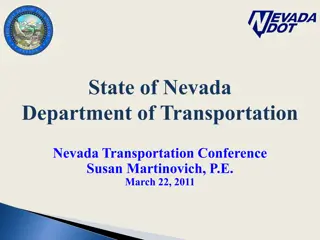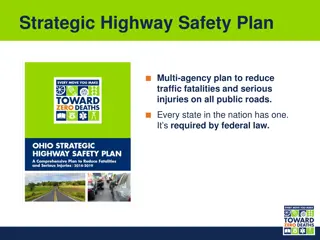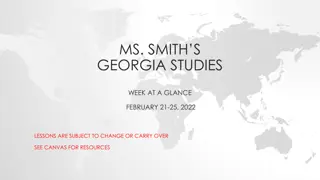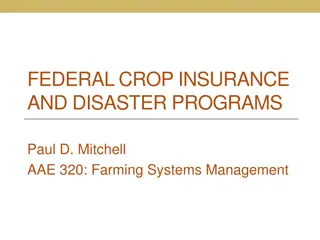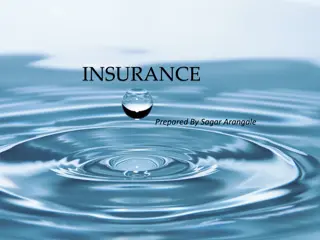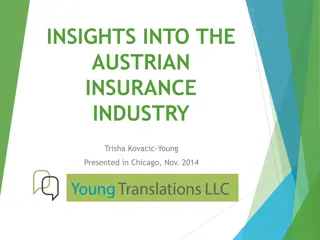Georgia Auto Insurance Trends & Highway Safety Analysis
This report delves into the trends shaping the private passenger auto insurance market in Georgia, highlighting competition profiles, claim severity, and loss ratio trends. It also examines the alarming rise in highway fatalities in the state, emphasizing the importance of road safety measures and the impact on insurance claim costs.
Download Presentation

Please find below an Image/Link to download the presentation.
The content on the website is provided AS IS for your information and personal use only. It may not be sold, licensed, or shared on other websites without obtaining consent from the author.If you encounter any issues during the download, it is possible that the publisher has removed the file from their server.
You are allowed to download the files provided on this website for personal or commercial use, subject to the condition that they are used lawfully. All files are the property of their respective owners.
The content on the website is provided AS IS for your information and personal use only. It may not be sold, licensed, or shared on other websites without obtaining consent from the author.
E N D
Presentation Transcript
Private Passenger Auto Insurance Trends in Georgia Georgia House and Senate Insurance Committees Atlanta, GA February 1, 2023 Robert P. Hartwig, PhD, CPCU Clinical Associate Professor of Finance, Risk Management & Insurance Darla Moore School of Business University of South Carolina Robert.Hartwig@moore.sc.edu 803.777.6782
Georgia Auto Insurance Market: Outline Georgia Auto Insurance Markets: Competition Profile Highway Deaths: Georgia s New Epidemic? Claim Severity and Loss Ratio Trends in Georgia: Rapid Deterioration Inflation: The Impact on Auto Insurance Claim Costs & Consequences Summary and Q&A
Georgia Auto Insurance Competition Profile Georgia s Auto Insurance Market Is Highly Competitive 3
Competition: The Facts About Georgia Auto Insurance Markets 211 Private Passenger Auto insurers competed for business in Georgia in 2021, writing some $10.5 billion in premiums on 4 million vehicles in the state, suggesting a large and vigorously competitive auto insurance mkt. The Georgia Private Passenger Auto Insurance market is very competitive according to the most commonly used competition metric employed the U.S. Department of Justice, the Herfindahl-Hirschman Index (HHI) The HHI value for Georgia s PPA market was 647 in 2021. According to the DOJ, any value below 1500 represents a market that it considers to be Not Concentrated Conclusion: By federal standards, GA s auto insurance market is very competitive. There is no evidence that a lack of competition is pressuring auto rates in GA.* *US Dept. of Justice accessed 3/22/22 at: https://www.justice.gov/atr/herfindahl-hirschman-index Source: University of South Carolina, Risk and Uncertainty Management Center from S&P Global Markets. 4
Auto Fatalities Are Soaring in Georgia Fatal Auto Accidents Increased Rapidly in Georgia Despite the Pandemic And Continue to Climb Most Deaths Are Due to Unsafe Driving Behaviors 5
Georgia Highway Fatalities, 20072022* +160 Deaths = 9.6% in 2021 Awareness of distracted-driving risks in GA increased materially in 2016/17 and Hands-Free Bill HB 673 became effective in 2018 +69 Deaths = 2,000 1,8241,893 3.8% in 2022E* 1,800 1,664 1,647 1,561 1,5491,497 1,491 1,508 1,600 1,432 1,353 1,400 1,2991,250 1,2361,199 1,189 1,170 1,353 GA highway fatalities through 9M 2022 (+3.8% from same period in 2021 vs. 0.2% for the US overall) 1,200 1,000 800 +262 Deaths = 600 +173 Deaths = +129 Deaths = +22.4% in 2015 400 +11.5% in 2020 +9.0% in 2016 200 0 07 08 09 10 11 12 13 14 15 16 17 18 19 20 21 22E 22:9M Highway fatalities have skyrocketed in Georgia in 2020 and 2021, reaching their highest levels in many years despite less driving overall during the pandemic *Full-year 2022 figure of 1,893 is estimated by applying the 3.8% increase in 9M actual fatalities in 2022 to 2021 full-year actual fatalities of 1,824 deaths. Sources: Georgia Department of Transportation data for years 2007 2018 and 2021 accessed 3/22/22 at: http://www.dot.ga.gov/DS/SafetyOperation/DAAA; Data for 2019-20 from National Highway Traffic Safety Administration, accessed at: https://www-fars.nhtsa.dot.gov/states/statesfatalitiesfatalityrates.aspx and Overview of Motor Vehicle Crash Statistics (Dec. 2022): https://crashstats.nhtsa.dot.gov/Api/Public/ViewPublication/813406.
During COVID, fatalities surged by 7.6% in 2020 and 10.5% in 2021 (up 18.9% since 2019) Traffic Fatalities in the U.S., 2000-2022E (Millions of Units) 43,510 46,000 43,005 42,884 42,836 42,915 42,708 42,380 42,196 41,945 41,259 44,000 Financial Crisis/ Great Recession fatalities fell 25.4% 42,000 38,824 Fatalities remained very elevated in 2022, falling by just 0.2% (est.) 37,806 37,473 37,423 40,000 36,560 36,096 35,484 38,000 33,883 33,782 36,000 32,999 32,893 32,744 32,479 34,000 32,000 30,000 00 01 02 03 04 05 06 07 08 09 10 11 12 13 14 15 16 17 18 19 20 21 22E Extraordinary Increase in Poor Driving Behaviors in 2020, 2021 and 2022 Contributed to Sharply Higher Auto Fatalities *2022 figure is annualized based on actual of 31,785 through Sept. 30 (a decline of 0.2% from the same period in 2021). Source: Insurance Institute for Highway Safety and Highway Loss Data Institute: https://www.iihs.org/iihs/topics/t/general-statistics/fatalityfacts/overview-of-fatality-facts and NHTSA (2022): https://www.nhtsa.gov/press-releases/early-estimates-traffic-fatalities-first-half-2022; Risk and Uncertainty Management Center, University of South Carolina. 7
U.S. Annual Change in Automobile Deaths, 1991- 2022* There were 42,915 traffic fatalities in 2021 (highest since 2007), up 18.9% from 2019 despite the pandemic Annual Change (%) Motor vehicle deaths saw their largest increase in 50 years in 2016 Steep drop due to less driving during the Great Recession Sharp increase in use of seatbelts 15% 10.5% 8.4% 7.6% 10% 6.5% 4.0% 2.7% 2.3% 5% 1.9% 1.6% 1.4% 0.6% 0.6% 0.5% 0.6% -0.1% -0.1% 0% -0.3% -0.2% -0.5% -0.9% -1.2% -1.6% -1.7% -1.8% -2.0% -2.6% -2.6% -5% -3.4% -5.44% -6.9% US traffic fatalities in 2022 remained stuck near recent highs -10% -9.3% -9.5% -15% 22* 91 92 93 94 95 96 97 98 99 00 01 02 03 04 05 06 07 08 09 10 11 12 13 14 15 16 17 18 19 20 21 Extraordinary Increase in Poor Driving Behaviors in 2020, 2021 and 2022 Leading to Sharply Higher Auto Fatalities *First 9 months 2022 vs. same period in 2021. Source: Insurance Institute for Highway Safety and Highway Loss Data Institute: https://www.iihs.org/iihs/topics/t/general-statistics/fatalityfacts/overview-of-fatality-facts and NHTSA (2021): https://crashstats.nhtsa.dot.gov/Api/Public/ViewPublication/813240; Risk and Uncertainty Management Center, University of South Carolina. 8
Motor Vehicle Traffic Fatality Rates, Top 15 States: 9M 2022 Fatalities per 100M Vehicle Miles Traveled 2.0 1.78 1.75 1.75 1.72 1.8 1.65 1.58 1.57 1.55 1.54 1.52 RI has the lowest traffic fatality rate in the US 1.50 1.6 1.43 1.42 1.41 1.39 1.30 1.4 1.2 GA had the 15th highest motor vehicle fatality rate in the US in 2022: 1.39 deaths per 100M VMT, up 3.8% from 2021* 1.0 0.8 0.64 0.6 0.4 0.2 0.0 SC AR NM MS MT OR LA AZ DE TX FL NC KY CO GA US RI *Figures are for the first 9 months of 2022 vs. the same period in 2021. Sources: NHTSA Traffic Safety Facts, Dec. 2022: https://crashstats.nhtsa.dot.gov/Api/Public/ViewPublication/813406; USC RUM Center. 9
Facts About Highway Deaths in Georgia in 2021* GDOT found that more than 3 out of every 4 highway deaths (76%) in 2021 were caused by unsafe drivng behaviors, 56% of victims weren t weaing seatlbelts and that 17.5% of victims were pedestrians 56% 17.5% 1,844 76% *Latest available. Source: Georgia Department of Transportation accessed 1/27/23 at: http://www.dot.ga.gov/DS/SafetyOperation/DAAA.
More Facts About Highway Deaths in Georgia in 2021* Nearly half of people killed in traffic accidents in GA were not wearing seatbelts Most fatal accidents involve more than one vehicle *Latest available. Source: Georgia Department of Transportation accessed 1/27/23 at: http://www.dot.ga.gov/DS/SafetyOperation/DAAA.
Back Behind the Wheel Americans Are Back Behind the Wheel Miles Driven Will Likely Set a New Record in 2022 12
Vehicle Miles Driven Have Rebounded Sharply Percent Change, Miles Driven* A sharp rebound in driving in 2021 brought total miles drive to within 1% of miles driven in 2019 7.6% 8.0% 2.9% 1.9%2.7% 1.7%2.1%1.5%2.2%1.9%1.0%0.4%0.3% 3.0% 1.2%0.4%0.8% 0.8% 0.1%0.6% -0.3% -0.3% -2.0% -2.1% Americans drove 358 billion fewer miles in 2020 than in 2019 -7.0% -12.0% -11.0% 01 03 05 07 09 11 13 15 16 17 18 19 20 21 22* Tremendous Growth In Miles Driven. The More People Drive, the More Frequently They Get Into Accidents. *Moving 12-month total vs. prior year through November 2022. Sources: Federal Highway Administration.
Travel in Trillions of Vehicle Miles in U.S.: 19962022* Miles driven in 2022 were virtually identical to 2019 3.5 3.271 3.263 3.236 3.206 3.171 3.163 3.081 3.037 3.013 3.009 2.985 2.986 2.981 2.973 2.964 2.958 2.952 2.947 2.946 2.883 2.851 3.0 2.777 2.749 2.664 2.608 2.552 2.482 Miles driven plunged by 11% in 2020 as the pandemic severely curtailed travel 2.5 2.0 96 97 98 99 00 01 02 03 04 05 06 07 08 09 10 11 12 13 14 15 16 17 18 19 20 21 22 Miles driven in 2022 returned to pre-prandemic levels, though was likely held back by soaring gas prices that could led vehicle owners to scale back on their driving *2022 figure is for the 12 months ending in Nov. 2022. Sources: Sources: Federal Highway Administration at https://www.fhwa.dot.gov/policyinformation/travel_monitoring/22novtvt/page2.cfm; USC RUM Center. 14
Private Passenger Auto Profitability in Georgia vs. US and Southeastern States Georgia is a Profitability Laggard in the Region and Among the 50 States 15
Return on Net Worth PP Auto: GA vs. U.S., 2005-2020 Average 2005-2020 US: 5.9% US:2020 = 10.5% 14% 12% GA: 3.4% 10% Fortune 500 = 13.8% 8% 6% 4% 2% 0% GA s Pvt. Passenger Auto market is far less profitable than the US market overall by far and has been since 2012-13 GA:2020 = 6.7% -2% -4% GA:2016 = -5.8% -6% -8% 05 06 07 08 US 09 10 11 12 13 14 15 16 17 18 19 20 GA Private Passenger Auto Insurers Sustained Significant Underwriting Losses in GA Between 2013 - 2016 Source: NAIC; University of South Carolina, Center for Risk and Uncertainty Management 16
RNW PP Auto: GA vs. SC,TN, FL, AL and the U.S., 2005-2020 15% 10% 5% 0% Average 2005-2020 US: 5.9% TN: 7.0% FL:6.6% AL:6.3% SC: 4.8% GA: 3.4% -5% GA s Pvt. Passenger Auto Market is the least profitable in the region, on average and has been since 2012 -10% -15% 05 06 US 07 08 TN 09 10 11 12 13 14 15 16 17 18 19 20 FL AL GA SC Source: NAIC; University of South Carolina, Center for Risk and Uncertainty Management. 17
Return on Net Worth: US Personal Auto, 2005-2020 18% 16% 14% 12% Average 2005-2020 Fortune 500: 13.8% US Personal Auto: 5.9% GA Personal Auto: 3.4% 10.5% 10% 8% 10.3% 6% 4% 2% 0% 05 06 07 08 09 10 11 12 13 14 15 16 17 18 19 20 US Personal Auto Fortune 500 U.S. Personal Auto Insurance Returns on Net Worth Are Less than Half that of the Fortune 500. In GA Returns in Personal Auto Are Barely Half that of the US and About 1/4 of the Fortune 500 Source: NAIC; University of South Carolina, Center for Risk and Uncertainty Management. 18
Private Passenger Auto Severity Trends in Georgia Claim Severity Echoes the Sharp Increase in Auto Crash Deaths Inflation Is Also Pressuring Severity and Pushing Loss Ratios Upward 19
U.S. Auto Physical Damage Loss Ratio Spikes to a 20+ Year High Auto physical damage loss ratios are up nearly 40 points since early in the pandemic and 24.4 points since 2019, before the pandemic began. The implication is that rates are under more pressure now than prior to Covid. 2019 = 62.2 Source: APCIA using S&P Global Market Intelligence; ratio of direct losses incurred and premiums earned; reflects personal and commercial business.
U.S. Inflation Rate: 2009-2022 Inflation accelerated sharply in 2021 and 2022 to a 40-year high Percentage Change (%) Inflation is being driven by many factors, including severe supply chain disruptions (esp. in the auto industry), labor shortages, commodities price inflation (e.g., steel, aluminum), rising energy prices and more 9.0% 8.0% 8.0% 7.0% 6.0% 4.7% 5.0% 4.0% 3.2% 3.0% 2.4% 2.1% 2.1% 1.8% 1.6% 1.6% 1.5% 2.0% 1.3% 1.2% 1.0% 0.1% 0.0% Insurer Concerns About Inflation Rate Inadequacy Reserve Inadequacy -0.4% 09 -1.0% 10 11 12 13 14 15 16 17 18 19 20 21 22 *Annual change in Consumer Price Index for All Urban Consumers (CPI-U). Source: U.S. Bureau of Labor Statistics; Wells Fargo Securities.
Cumulative Price Changes (All Items): U.S. City Average vs. Atlanta-Sandy Springs-Roswell GA Metro Area +26% +21% Inflation has been materially higher in the Atlanta metro area than in the US overall since early 2021. This includes items that factor into the cost of auto insurance including new and used vehicles, repairs, rental vehicles and medical services. Source: U.S. Bureau of Labor Statistics.
Georgia Increases in Claim Severity by Coverage: 2022:Q3 vs. 2020* Collision claim severity is up by more than 40% since 2020 45% 41.5% 40% 35.6% 35% 30% 22.9% 25% 20% 15% 7.8% 10% 5% 0% Collision Property Damage Liability Bodily Injury Liability Comprehensive Claim Severities Are Up Sharply in GA in 2022 (and 2021) Across All Major Coverages: Inflation, Proliferation of Poor Driving Behaviors and Pandemic Recovery Are All Driving Claims Costs Upward *2022:Q3 figure vs. full-year 2020. Source: ISO/PCI Fast Track data; Risk and Uncertainty Management Center, University of South Carolina. 23
Georgia Bodily Injury Liability Frequency and Severity: Percent Change Since Q1: 2019 (Rolling 4 Quarters) Bodily injury severity in Georgia is skyrocketing and swamps the pandemic-driven decline in frequency (which is recovering quickly) Source: APCIA using Fast Track Monitoring System, ISS Fast Track Plus.
Georgia Bodily Injury Liability Frequency, Severity and Loss Cost: Percent Change Since Q1: 2019 (Rolling 4 Quarters) BI Loss Cost in GA is up 29.1% since 2019:Q1, driven by skyrocketing claim severity with only modest (and shrinking) offsets in claim frequency Source: APCIA using Fast Track Monitoring System, ISS Fast Track Plus.
Georgia Bodily Injury Claim Severity (Avg. Loss), 2016 2022:Q3* $30,000 $26,578 $25,953 $24,482 $24,285 $25,000 $21,109 $19,756 $20,000 $17,996 $17,554 $15,646 $15,000 Georgia Bodily Injury Liability average loss (severity) reached a record high of $26,578 in Q2:2022, up 25.9% from 2020 $10,000 $5,000 $0 16 17 18 19 20 21 22:Q1 22:Q2 22:Q3 The average cost of Bodily Injury Liability claims is rising rapidly in Georgia *Latest available. Sources: Sources: ISO Fast Track as of Q3 2022; USC Risk and Uncertainty Management Center. 26
Georgia Bodily Injury Liability Severity: Sharp Increase in Claims Costs Underway* 16% 15.0% Bodily Injury Liability claim costs are up sharply in recent years 14% 12.2% 12% 10.0% 9.1% 10% 8% 6.8% 6% 4% 2.3% 2% 0% 17 18 19 20 21 22:Q3 Inflation, Pandemic Recovery, Poor Driving Behaviors Are Causing Claim Costs to Surge in Georgia *2022 figures is for the 4 quarters ending in Q3 2022. Source: ISO/PCI Fast Track data; Risk and Uncertainty Management Center, University of South Carolina. 27
Georgia Property Damage Liability: Average Loss, 2016 2022:Q3* $7,000 $6,217 $5,947 $5,853 $6,000 $5,100 $5,000 $4,585 $4,210 $3,983 $3,813 $4,000 $3,597 Georgia Property Damage Liability average loss (severity) reached a new record high of $6,217 in Q3:2022, up 35.6% from 2020 $3,000 $2,000 $1,000 $0 16 17 18 19 20 21 22:Q1 22:Q2 22:Q3 The average cost of Property Damage Liability claims is rising rapidly in Georgia. Accelerating inflation is a major factor. *Latest available. Sources: Sources: ISO Fast Track as of Q3 2022; USC Risk and Uncertainty Management Center. 28
Georgia Property Damage Liability Severity: Sharp Increase in Claims Costs Underway* 25% Property Damage Liability claim costs are up sharply 22.4% 21.2% 20% 17.3% 15% 11.2% 8.9% 10% 6.0% 5.7% 4.5% 5% 0% 17 18 19 20 21 22:Q1 22:Q2 22:Q3 Inflation, Pandemic Recovery, Poor Driving Behaviors Are Causing Claim Costs to Surge in Georgia *Quarterly data for 2022 show change relative to the same quarter in prior year. Source: ISO/PCI Fast Track data; Risk and Uncertainty Management Center, University of South Carolina. 29
Georgia Collision Claim Average Loss, 20162022:Q3* $7,000 $6,004 $5,969 $6,000 $5,635 $5,217 $5,000 $4,218 $4,123 $3,898 $3,770 $3,698 $4,000 $3,000 Georgia Collision claim average loss (severity) was at a near- record high of $5,969 in Q3:2022, up 41.5% from 2020 $2,000 $1,000 $0 16 17 18 19 20 21 22:Q1 22:Q2 22:Q3 The average Collision claim cost is rising rapidly in Georgia as inflation, poor driving behaviors and the pandemic recovery all drive losses upward *Latest available. Sources: Sources: ISO Fast Track as of Q3 2022; USC Risk and Uncertainty Management Center. 30
Georgia Collision Claim Severity: Sharp Increase in Claims Costs Underway* 30% 26.0% Collision claim costs are up sharply 23.7% 25% 22.1% 20% 15% 10% 7.3% 5.8% 5.4% 5% 2.3% 0% -1.9% 17 -5% 18 19 20 21 22:Q1 22:Q2 22:Q3 Inflation, Pandemic Recovery, Poor Driving Behaviors Are Causing Claim Costs to Surge in Georgia *Quarterly data for 2022 show change relative to the same quarter in prior year. Source: ISO/PCI Fast Track data; Risk and Uncertainty Management Center, University of South Carolina. 31
GAs Collision loss ratio is up 23.1 points since Q1: 2021 and as of Q3:2022 is 20 points above the 5-year average of 68.8% Collision Loss Ratio Trending Upward: Pvt. Passenger Auto, GA vs. US, 2010 2022:Q3* Loss Ratio 2016-2020 5-Year Avg = 68.8% (US and GA) 93.9% 100% 89.3% 88.8% 88.1% 88.3% 87.7% 87.7% 95% 86.1% 85.3% 84.4% 90% 85% 72.2% 80% 70.9% 75% 70% 65% 65.7% 66.2% 60% 55% 50% 21:Q1 21:Q2 21:Q3 21:Q4 22:Q1 22:Q2 22:Q3 US GA Collision Loss Ratios Are Rising Rapidly and Are Far Above the 5-Year Average *Latest available. Source: ISO/PCI Fast Track data; Risk and Uncertainty Management Center, University of South Carolina. 32
Georgia Comprehensive Claim Severity (Avg. Loss), 2016 2022:Q3* $3,000 $2,393 $2,500 $2,183 $2,129 $1,876 $2,000 $1,830 $1,780 $1,649 $1,500 Georgia Comprehensive claim severity (average loss) reached $2,382 in 2022**, up 12.4% from 2020 and 27.6% from 2019 $1,000 $500 $0 16 17 18 19 20 21 22** The average Comprehensive claim cost is rising rapidly in Georgia as inflation, severe weather and the pandemic recovery all drive losses upward *Latest available. **2022 figure is for the four quarters ending in 2022:Q3. Sources: Sources: ISO Fast Track as of Q3 2021; USC Risk and Uncertainty Management Center. 33
Georgia Comprehensive Claim Severity Costs Are Rising: Severe Weather, Inflation Play Roles* 16% Comprehensive claim costs are up materially since 2020 13.5% 14% 11.0% 12% 8.4% 10% 8% 6% 4% 2.5% 2.4% 2% 0% -2% -2.7% 18 -4% 17 19 20 21 22* Severe Weather, Inflation, Crime Are Causing Comprehensive Claim Costs to Surge in Georgia *2021 figure is for the four quarters ending 2022:Q3. Source: ISO/PCI Fast Track data; Risk and Uncertainty Management Center, University of South Carolina. 34
U.S. Inflation-Adjusted Insured CAT Losses: 1980 2022:Q3* Harvey, Irma, Maria Ida ($36B) TX Freeze ($15B) Katrina, Rita, Wilma 112 $110 Average for Decade Hurricane Andrew $100 85 WTC $90 85 Billions, 2021 $ $80 70 70 $70 2000s: $27 B 57 Weather events cause billions in damage to vehicles each year $60 2010s: $37 B 1990s: $16 B $50 44 40 $40 1980s:$5 B 28 $30 $20 $10 $0 20 21 22: 19 80 81 82 83 84 85 86 87 88 89 90 91 92 93 94 95 96 97 98 99 00 01 02 03 04 05 06 07 08 09 10 11 12 13 14 15 16 17 18 Q3 Average Insured Loss per Year* 1980-2021: $23.8 Billion 2012-2021: $44.1 Billion The 2020s are off to an ominous start with $76B in average annual insured losses (2020-21) *Stated in 2021 dollars except 2022:Q3 (2022 dollars). Sources: Property Claims Service, a Verisk Analytics business (1980-2019); 2020-21 figures from Munich Re; 2023 YTD data from Aon; Insurance Information Institute; University of South Carolina, Risk & Uncertainty Management Center.
Private Passenger Auto & Inflation Personal Auto Is Experiencing Significant Inflationary Pressure from Multiple Sources Claim Severities and Loss Ratios Are Rising Rapidly 36 36
U.S. Inflation Rate: 2009-2022 Inflation accelerated sharply in 2021 and 2022. Percentage Change (%) Inflation is being driven by many factors, including severe supply chain disruptions (esp. in the auto industry), labor shortages, commodities price inflation (e.g., steel, aluminum), rising energy prices and more 9.0% 8.0% 8.0% 7.0% 6.0% 4.7% 5.0% 4.0% 3.2% 3.0% 2.4% 2.1% 2.1% 1.8% 1.6% 1.6% 1.5% 2.0% 1.3% 1.2% 1.0% 0.1% 0.0% Insurer Concerns About Inflation Rate Inadequacy Reserve Inadequacy -0.4% 09 -1.0% 10 11 12 13 14 15 16 17 18 19 20 21 22 *Annual change in Consumer Price Index for All Urban Consumers (CPI-U). Source: U.S. Bureau of Labor Statistics; Wells Fargo Securities.
Price Index Changes for New Vehicles (% Change from Year Ago), Jan. 1973 Dec. 2022 High demand and supply chain problems have caused new vehicle prices to surge at their fastest pace since 1975. Problems will likely persist through 2023. Apr. 2022 +13.2% Mar. 1975 +12.7% Dec. 2022 +5.9% Sources: US Bureau of Labor Statistics; Risk and Uncertainty Management Center, University of South Carolina.
Price Index Changes for Used Cars & Trucks, Jan. 2020 Dec. 2022 New and Used Vehicle prices surged during the pandemic, +54.6% from Jan. 2020 before peaking in Jan. 2022 putting significant pressure on the overall CPI (new and used vehicles account for 7.5% of the index and gasoline 2.8% auto insurance is 1.6% ) Used car prices remain stubbornly high and are still far above pre-Covid levels (+38.9% from Jan. 2020-Dec. 2022) +54.6%: Jan. 2020 Jan. 2022 +38.9%: Jan. 2020 Dec. 2022 Sources: US Bureau of Labor Statistics; Risk and Uncertainty Management Center, University of South Carolina.
Change in Price for Replacement Passenger Car Rentals, Jan. 2010 Dec. 2022 (% Change from Year Ago) High demand and supply chain problems have caused new vehicle prices to surge at their fastest pace since 1975. Problems will likely persist into 2023. May 2012 +21.5% Oct. 2021 +20.2% Dec. 2022 +5.3% Sources: US Bureau of Labor Statistics; Risk and Uncertainty Management Center, University of South Carolina.
Length of Collision Replacement Rentals by State (Days), 2022:Q3 Avg. Length of U.S. Rental 2022:Q3: 18.2 days 2021:Q3: 15.2 days 2020:Q3: 12.3 days CHANGE: +3.0 Days over the past 4 quarters and +5.9 days since 2020:Q3 Avg. Length of GA Rental 2022:Q3: 21.0 days 2021:Q3: 17.1 days 2020:Q3: 12.5 days CHANGE: +3.9 Days over the past 4 quarters and +8.5 days since 2020:Q3 Length of rental replacement in GA at 21.0 days is tied (with OK) for second highest in the US, trailing only LA (22.2 days) Source: Enterprise Rental-A-Car U.S. Length of Rental Report accessed via Repair Driver News at: https://www.repairerdrivennews.com/2022/10/31/average-length-of-rental-up-by-nearly-one-third-since-2020-enterprise-reports/
Auto/Light Truck Sales, 1999-2024F New vehicle production problems are resulting in higher costs for new, used and replacement vehicles (and parts) Job growth and improved credit market conditions boosted auto sales to near record levels by 2015/16 (Millions of Units) 19 17.8 17.5 17.4 17.5 17.4 17.1 17.2 17.1 16.9 17.0 18 16.9 16.6 16.5 16.4 16.1 17 15.5 16 14.9 14.5 14.4 15 13.8 13.2 14 12.7 13 New vehicle purchases remain constrained by manufacturer supply chain problems 11.6 New auto/light truck sales fell to the lowest level since the late 1960s. 12 10.4 11 10 9 99 00 01 02 03 04 05 06 07 08 09 10 11 12 13 14 15 16 17 18 19 20 21 22 Yearly car/light truck sales remain below pre-COVID levels. Auto manufacturer supply chain issues are expected to linger into early 2023. PP Auto premium might grow by 4%-5%. Source: U.S. Department of Commerce; Wells Fargo Securities (1/23 for 2022-24F); Univ. of South Carolina, Center for Risk and Uncertainty Management.. 42
Medical Cost Inflation, Jan. 2020 Dec. 2022 (Percent Change from Year Ago) 7.0 Peak Aug. 2022: 6.0% 6.0 The cost of medical care surged in 2022 as well, pushing up the cost of treating motor vehicle injuries 5.0 4.0 Dec. 2022: 4.0% 3.0 2.0 1.0 0.0 Jan 20 Mar 20 May 20 Jul 20 Sep 20 Nov 20 Jan 21 Mar 21 May 21 Jul 21 Sep 21 Nov 21 Jan 22 Mar 22 May 22 Jul 22 Sep 22 Nov 22 Sources: US Bureau of Labor Statistics; Risk and Uncertainty Management Center, University of South Carolina.
SUMMARY Georgia has a very competitive auto insurance market, but Georgia s highways are becoming increasing deadly The insurance industry s claim experience mirrors the sharp increase in Georgia highway fatalities Georgia today has extremely adverse auto claim severity trends Rising claim severities are pushing loss ratios higher, well above pre- pandemic levels Inflationary pressures remain, affecting the cost of new and used vehicles, parts, labor, replacement vehicles, and medical care Rate adequacy is an immediate concern for auto insurers as loss ratios soar 44
Thank you for your time and your attention! Twitter: twitter.com/bob_hartwig For a copy of this presentation, email me at robert.hartwig@moore.sc.edu or Download at www.uscriskcenter.com 45
